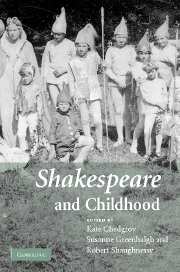1 - Introduction
Published online by Cambridge University Press: 22 September 2009
Summary
On the front cover of this book is a detail from a photograph, taken in 1930, of a group of some thirty children in an amateur performance of A Midsummer Night's Dream, designed and directed by Rowena Cade for the open-air theatre at Minack in Cornwall. Standing, crouching and kneeling before a woodland backdrop, some with arms draped over others' shoulders, others clutching garlands and long wands (excepting one figure towards the extreme left of the picture, who scowls at the camera, arms defiantly folded), these young persons range in age from preschool to teenage. Clad in home-sewn tights, tunics, acorn-cup headgear and (for Oberon and Titania) cloaks and ruffs, the members of this motley assembly of elves, sprites and pixies squint uncomfortably into the glare of an English sun that strips the sylvan scene of any vestige of nocturnal mystery or magic. Still, the broad provenance of this memento of Shakespearean performance is readily identifiable, even if the nature of the children's investment in the event it commemorates is not; it images a relationship between Shakespeare, childhood and performance that is liable to provoke a variety of reactions, ranging from indulgent amusement to faint nausea. On the one hand, the conjunction of the child, the fairy, performance and Shakespeare may evoke a lost time and space of naïve pleasure and innocent make-believe, a prospect to be contemplated with deep nostalgia, as befitting the Dream's special status as the scene of many Shakespeare-lovers' first encounter with the Bard.
- Type
- Chapter
- Information
- Shakespeare and Childhood , pp. 1 - 12Publisher: Cambridge University PressPrint publication year: 2007
- 1
- Cited by



